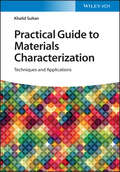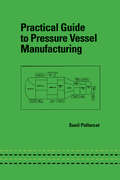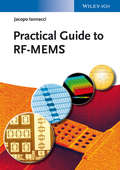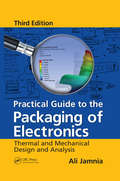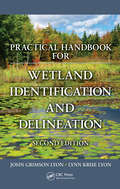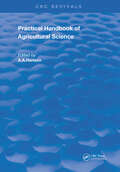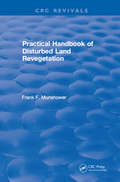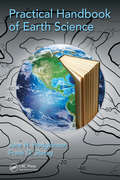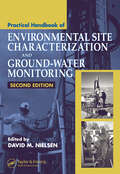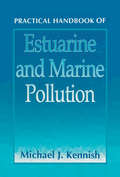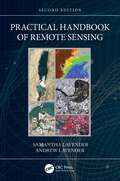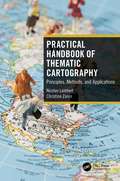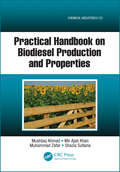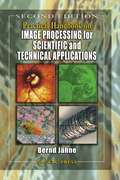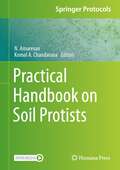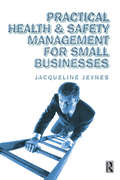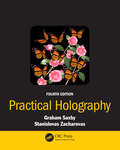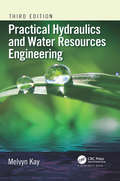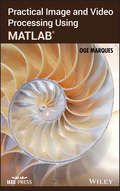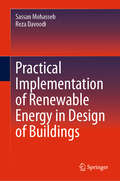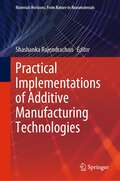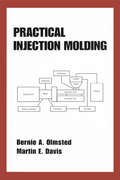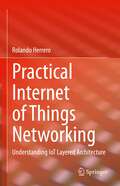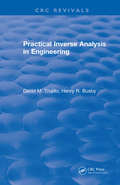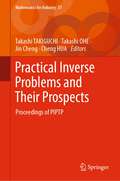- Table View
- List View
Practical Guide to Materials Characterization: Techniques and Applications
by Khalid SultanPractical Guide to Materials Characterization Practice-oriented resource providing a hands-on overview of the most relevant materials characterization techniques in chemistry, physics, engineering, and more Practical Guide to Materials Characterization focuses on the most widely used experimental approaches for structural, morphological, and spectroscopic characterization of materials, providing background, insights on the correct usage of the respective techniques, and the interpretation of the results. With a focus on practical applications, the work illustrates what to use and when, including real-life examples showing which characterization techniques are best suited for particular purposes. Furthermore, the work covers the practical elements of the analytical techniques used to characterize a wide range of functional materials (both in bulk as well as thin film form) in a simple but thorough manner. To aid in reader comprehension, Practical Guide to Materials Characterization is divided into eight distinct chapters. To set the stage, the first chapter of the book reviews the fundamentals of materials characterization that are necessary to understand and use the methods presented in the ensuing chapters. Among the techniques covered are X-ray diffraction, Raman spectroscopy, X-ray spectroscopy, electron microscopies, magnetic measurement techniques, infrared spectroscopy, and dielectric measurements. Specific sample topics covered in the remaining seven chapters include: Bragg’s Law, the Von Laue Treatment, Laue’s Equation, the Rotating Crystal Method, the Powder Method, orientation of single crystals, and structure of polycrystalline aggregates Classical theory of Raman scattering, quantum theory of Raman spectroscopy, high-pressure Raman spectroscopy, and surface enhanced Raman spectroscopy Basic principles of XAS, energy referencing, XPS spectra and its features, Auger Electron Spectroscopy (AES), and interaction of electrons with matter Magnetization measuring instruments, the SQUID magnetometer, and the advantages and disadvantages of vibrating sample magnetometer (VSM) With comprehensive and in-depth coverage of the subject, Practical Guide to Materials Characterization is a key resource for practicing professionals who wish to better understand key concepts in the field and seamlessly harness them in a myriad of applications across many different industries.
Practical Guide to Pressure Vessel Manufacturing
by Sunil Kumar PullarcotThis text explains vessel manufacture and procedures for quality assurance and control, methods for code specification compliance, all stages of the manufacturing process, and promotes uniformity of inspection, testing, and documentation. Analyzing radiographic testing procedures, the book acts as an explanation to the ASME code, features the A to Z of fabrication methodology, discusses NDT, heat treatment, and pad air and hydrostatic tests, methodology to compile a Manufacturer's Data Report, typical quality, inspection, and test plans, the requirements of welding procedure specification, procedure qualification records, and welder qualification tests, and recommended tolerances for vessels.
Practical Guide to RF-MEMS
by Jacopo IannacciCloses the gap between hardcore-theoretical and purely experimental RF-MEMS books.The book covers, from a practical viewpoint, the most critical steps that have to be taken in order to develop novel RF-MEMS device concepts. Prototypical RF-MEMS devices, both including lumped components and complex networks, are presented at the beginning of the book as reference examples, and these are then discussed from different perspectives with regard to design, simulation, packaging, testing, and post-fabrication modeling. Theoretical concepts are introduced when necessary to complement the practical hints given for all RF-MEMS development stages.Provides researchers and engineers with invaluable practical hints on how to develop novel RF-MEMS device conceptsCovers all critical steps, dealing with design, simulation, optimization, characterization and fabrication of MEMS for radio-frequency applicationsAddresses frequently disregarded issues, explicitly treating the hard to predict interplay between the three-dimensional device structure and its electromagnetic functionalityBridges theory and experiment, fundamental concepts are introduced with the application in mind, and simulation results are validated against experimental resultsAppeals to the practice-oriented R&D reader: design and simulation examples are based on widely known software packages such as ANSYS and the hardware description language Verilog.
Practical Guide to the Packaging of Electronics: Thermal and Mechanical Design and Analysis, Third Edition (Dekker Mechanical Engineering Ser.)
by Ali JamniaSuccessfully Estimate the Thermal and Mechanical Characteristics of Electronics Systems A definitive guide for practitioners new to the field or requiring a refresher course, Practical Guide to the Packaging of Electronics: Thermal and Mechanical Design and Analysis, Third Edition provides an understanding of system failures and helps identify the areas where they can occur. Specifically designed for the mechanical, electrical, or quality engineer, the book addresses engineering issues involved in electronics packaging and provides the basics needed to design a new system or troubleshoot a current one. Updated to reflect recent developments in the field, this latest edition adds two new chapters on acoustic and reliability fundamentals, and contains more information on electrical failures and causes. It also includes tools for understanding heat transfer, shock, and vibration. Additionally, the author: Addresses various cross-discipline issues in the design of electromechanical products Provides a solid foundation for heat transfer, vibration, and life expectancy calculations Identifies reliability issues and concerns Develops the ability to conduct a more thorough analysis for the final design Includes design tips and guidelines for each aspect of electronics packaging Practical Guide to the Packaging of Electronics: Thermal and Mechanical Design and Analysis, Third Edition explains the mechanical and thermal/fluid aspects of electronic product design and offers a basic understanding of electronics packaging design issues. Defining the material in-depth, it also describes system design guidelines and identifies reliability concerns for practitioners in mechanical, – electrical or quality engineering.
Practical Handbook for Wetland Identification and Delineation (Mapping Science)
by John G. Lyon Lynn Krise LyonWetland identification, although theoretically straightforward, is not cut and dry as a practice. Despite the time and expense, it is an economic and environmental necessity. The Definitive Guide to the Practice of Wetland IdentificationThe second edition of the bestselling Practical Handbook for Wetland Identification and Delineation offers soluti
Practical Handbook of Agricultural Science (Routledge Revivals)
by A. A. HansonFirst published in 1990, this new handy guide book is a "quick reference" to a variety of topics pertaining to soils, and to the production and use of plants and animals. Emphasis has been devoted to basic considerations in plant adaptation, soils, seeds, major field crops, and selected aspects of animal science. A reasonable amount of background information on most topics selected for inclusion is furnished, providing the reader with critical information on the subject matter presented, in the absence of access to other source materials. Attention has been given to the inclusion of both common and scientific plant names, various conversion tables, tabular material used in the interpretation of certain statistical tests, and a glossary, albeit abridged, of terms encountered in the improvement and management of soils, plants, and animals.
Practical Handbook of Disturbed Land Revegetation
by F.F. MunshowerThis crucial reference focuses on the growth of vegetation on disturbed lands, specifically the problems of plant seeding and growth and the ecological consequences of that growth. This one-of-a-kind book covers the spectrum of plant development, including the creation of an acceptable rooting medium and seeding or planting, and discusses practices to enhance diversity and usefulness of the plant community.This handbook gives detailed examples of how to rehabilitate and restore damaged land and, in most cases, mined land. The book focuses on the complete restoration of soil, water, vegetation, and wildlife. It provides a thorough introduction to the science behind the practice and follows with practical examples. A complete, detailed list of genera and species to expedite restoration is also included.
Practical Handbook of Earth Science
by Jane H. Hodgkinson Frank D. StaceyThis self-contained handbook provides a carefully researched, compact source of key earth science information and data, logically sorted by subject matter, and then cross-referenced. Appealing to both experts and non-experts alike, the book presents earth science and environmental science as closely intertwined. It includes tables of the global distributions of fossil fuels, contrasted by tables of the distribution of non-fossil energy sources. Concise explanations cover the subject matters of geology, geophysics, oceans, atmosphere with attention to environmental implications and resources.
Practical Handbook of Environmental Site Characterization and Ground-Water Monitoring
by David M. NielsenPublished in 1991, the first edition of The Practical Handbook of Ground-Water Monitoring quickly became the gold standard reference on the topic of ground-water monitoring. But, as in all rapidly evolving fields, regulations change, technology advances, methods improve, and research reveals flaws in prior thinking. As a consequence, books t
Practical Handbook of Estuarine and Marine Pollution (CRC Marine Science #10)
by Michael J. KennishThis extensive handbook presents up-to-date coverage of significant developments in estuarine and marine pollution. Multidisciplinary in approach, Practical Handbook of Estuarine and Marine Pollution is an essential resource for anyone involved in the study or management of coastal and marine pollution problems. The book examines in detail anthropogenic effects on estuarine and marine ecosystems from local, regional, and global perspectives. A truly international collection of data is presented in an organized framework on a wide range of subject areas, including eutrophication, organic loading, oil pollution, polycyclic aromatic hydrocarbons, halogenated hydrocarbons, trace metals, radioactive waste, dredging and dredged-spoil disposal, and effects of electric generating stations. Whether you are a student, a scientist, a policy maker, or an administrator, you no longer need to spend countless hours rounding up information and data - Practical Handbook of Estuarine and Marine Pollution has already done it for you.
Practical Handbook of Remote Sensing
by Samantha Lavender Andrew LavenderThe number of Earth observation satellites launched in recent years is growing exponentially, along with the datasets they gather from free-to-access and commercial providers. The second edition of Practical Handbook of Remote Sensing is updated with new explanations and practical examples using the Copernicus satellite data and new versions of the open-source software. A new chapter and new applications have also been added. Thoroughly revised, the handbook continues to be a practical "how-to" remote sensing guide for those who want to use the technology, understand what is available, how to access it, and answer questions about our planet, but do not necessarily want to become scientific experts.
Practical Handbook of Thematic Cartography: Principles, Methods, and Applications
by Nicolas Lambert Christine ZaninMaps are tools used to understand space, discover territories, communicate information, and explain the results of geographical analysis. This practical handbook is about thematic cartography. With more than 120 colorful amazing illustrations, numerous boxed texts, definitions, and helpful tools, this step-by-step introduction to cartography is both the art of understanding the world and a powerful tool for explaining it. Through many hands-on tests, the reader will learn how to produce an interesting and communicative map applied to any spatial theme. Written by experienced scholars and experts in cartography, this book is an excellent resource for undergraduate students and non-cartographers interested in designing, understanding, and interpreting maps. It includes practical exercises explained in the form of a game and provides a concise, accessible, and current address of cartographic principles, allowing readers to go deeper into cartographic design. It can be read from beginning to end like an essay or just by dipping into it for information as needed.
Practical Handbook on Biodiesel Production and Properties (Chemical Industries)
by Mushtaq Ahmad Mir Ajab Khan Muhammad Zafar Shazia SultanaBiodiesel-a fuel substitute produced from vegetable oils, animal fats, or algae-is one of the most important renewable natural resources for agrarian countries. The justification for developing biodiesel as an alternate fuel is manifold, and rising crude oil prices and the vulnerability of energy security have made biodiesel necessary and inevitabl
Practical Handbook on Image Processing for Scientific and Technical Applications
by Bernd JahneThe second edition of a bestseller, this book is a practical guide to image processing for the natural and technical sciences community. Students, practitioners, and researchers can gain immediate access to a sound basic knowledge of image processing by referencing general principles in the natural sciences. The book describes carefully selected algorithms in detail and demonstrates real-world applications that show the reader how to solve complex image processing problems. Hundreds of photos, figures, diagrams, and tables illustrate the text, and numerous well-organized tips save countless hours in the practical handling of image acquisition and processing.
Practical Handbook on Soil Protists (Springer Protocols Handbooks)
by N. Amaresan Komal A. ChandaranaThis volume details a wide range of basic and advanced techniques associated with research on isolation of important soil protozoa, and identification. Chapters guide readers through calculations of soil protists, basic techniques for isolation, enumeration, enrichment, molecular techniques, and staining techniques. Authoritative and cutting-edge, Practical Handbook on Soil Protists aims to ensure successful results in the further study of this vital field.
Practical Health and Safety Management for Small Businesses
by Jacqueline JeynesLooking at the needs of small businesses, this book takes you through all the aspects of Health and Safety management in a small business step-by-step. It takes a straightforward, practical approach to identifying, organising and managing Health, Safety and Fire risks in your business. Whatever your motivation for choosing this guide, it will provide a sound basis for establishing a system or approach that is relevant to the individual business concerned. Practical Health and Safety Management for Small Businesses will help you to identify all the potential hazards, offering advice on how best to look after your employees and how to manage Health and Safety in your business. It has been produced as a direct result of recent research, based on discussions with Health and Safety Inspectors, the Fire Authorities, Insurance representatives, Health and Safety professionals, and of course, Small Businesses themselves. Taking into account the practical issues faced in small business units, this guide takes you through all the main aspects of managing fire, health and safety step-by-step.Practical Health and Safety Management for Small Businesses will help you establish a system that you can maintain, add-to and keep up-to-date as official regulations and your needs change. It is NOT a legal textbook, but IS a practical guide on how to establish an approach to organising and managing these issues. While following this guide cannot guarantee that your business now fully complies with all the relevant legislation that applies to it, it does enable you to demonstrate to others that you have made a reasonable attempt at bringing all these different elements together in a structured, holistic way.Full of practical advice sample Site Plans and Checklists, photographs and industry-specific sections, Practical Health and Safety Management for Small Businesses will prove an invaluable guide for all those involved in running smaller business units, as well as those offering support, advice or guidance to SMEs.The author, Jacqueline Jeynes, has run her own small business for 13 years and has represented the concerns of UK small firms internationally for seven years, through the Federation of Small Businesses' Policy unit. She has appeared in 10 BBC TV programmes on health and safety in small firms and is currently a UK member of the Advisory Committee to the European Commission on Safety, Health and Hygiene.
Practical Holography
by Graham Saxby Stanislovas ZacharovasContinuing in the steps of its predecessors, the fourth edition of Practical Holography provides the most comprehensive and up-to-date resource available. Focused on practical techniques in holography at all levels, it avoids any unnecessary mathematical theory.Features of the Fourth EditionHighlights new information on color holograms, sensitive m
Practical Hydraulics and Water Resources Engineering (Third Edition)
by Melvyn KayWater is now at the centre of world attention as never before and more professionals from all walks of life are engaging in careers linked to water – in public water supply and waste treatment, agriculture, irrigation, energy, environment, amenity management, and sustainable development. This book offers an appropriate depth of understanding of basic hydraulics and water resources engineering for those who work with civil engineers and others in the complex world of water resources development, management, and water security. It is simple, practical, and avoids (most of) the maths in traditional textbooks. Lots of excellent ‘stories’ help readers to quickly grasp important water principles and practices. This third edition is broader in scope and includes new chapters on water resources engineering and water security. Civil engineers may also find it a useful introduction to complement the more rigorous hydraulics textbooks.
Practical Image and Video Processing Using MATLAB
by Oge MarquesUp-to-date, technically accurate coverage of essential topics in image and video processingThis is the first book to combine image and video processing with a practical MATLAB®-oriented approach in order to demonstrate the most important image and video techniques and algorithms. Utilizing minimal math, the contents are presented in a clear, objective manner, emphasizing and encouraging experimentation.The book has been organized into two parts. Part I: Image Processing begins with an overview of the field, then introduces the fundamental concepts, notation, and terminology associated with image representation and basic image processing operations. Next, it discusses MATLAB® and its Image Processing Toolbox with the start of a series of chapters with hands-on activities and step-by-step tutorials. These chapters cover image acquisition and digitization; arithmetic, logic, and geometric operations; point-based, histogram-based, and neighborhood-based image enhancement techniques; the Fourier Transform and relevant frequency-domain image filtering techniques; image restoration; mathematical morphology; edge detection techniques; image segmentation; image compression and coding; and feature extraction and representation.Part II: Video Processing presents the main concepts and terminology associated with analog video signals and systems, as well as digital video formats and standards. It then describes the technically involved problem of standards conversion, discusses motion estimation and compensation techniques, shows how video sequences can be filtered, and concludes with an example of a solution to object detection and tracking in video sequences using MATLAB®.Extra features of this book include:More than 30 MATLAB® tutorials, which consist of step-by-step guides to exploring image and video processing techniques using MATLAB®Chapters supported by figures, examples, illustrative problems, and exercisesUseful websites and an extensive list of bibliographical referencesThis accessible text is ideal for upper-level undergraduate and graduate students in digital image and video processing courses, as well as for engineers, researchers, software developers, practitioners, and anyone who wishes to learn about these increasingly popular topics on their own.Supplemental resources for readers and instructors can be found at http://www.ogemarques.com
Practical Implementation of Renewable Energy in Design of Buildings
by Sassan Mohasseb Reza DavoodiThis book demonstrates the enormous possibility of energy saving and reduction of CO2 emission achievable through zero-energy buildings, a building not dependent on outside energy sources. It describes technical and economical merits of utilizing renewable energies in building sectors that are not subject to factors such as disruption or price increase due to invasion, wars or sanctions. Three different buildings located in a cold climate in the northeastern USA and warm climate conditions, in California, are examined in this book. The energy balance before retrofitting and afterwards are compared and described for each of the study properties.
Practical Implementations of Additive Manufacturing Technologies (Materials Horizons: From Nature to Nanomaterials)
by Shashanka RajendrachariThis book gives in-depth information about evolution of additive manufacturing from a few decades to the present explaining how the technology has been improved with time and its practical implementation of the technology in various applications and industries. It describes the different types of additive manufacturing methods used to prepare materials and their advantages, followed by the limitations. This includes the fabrication of metal, polymer, biomaterial, hybrid nanomaterial, smart material, and ceramic materials using additive manufacturing methods used in many applications such as 3D printed batteries, supercapacitors, electrochemical sensors, biosensors, aircraft interior components, rocket engines components, automobile components, and medical implants. It also describes advanced applications of additive manufacturing materials in the construction, biomedical, and sports industries. In addition, the book also deep dives into the environmental impact and economic benefits of additive manufacturing industries. A special chapter is included to give an overview on the general type of job opportunities for engineering graduates and research scholars seeking to find employment in additive manufacturing companies. In short, the content of this book targets primarily researchers, engineering students (bachelors and masters), and industrial engineers.
Practical Injection Molding (Plastics Engineering)
by Bernie A. Olmsted Martin E. DavisThis work focuses on the factors critical to successful injection moulding, including knowledge of plastic materials and how they melt, the importance of mould design, the role of the screw, and the correct use of the controls of an injection moulding machine. It seeks to provide operating personnel with a clear understanding of the basics of injec
Practical Internet of Things Networking: Understanding IoT Layered Architecture
by Rolando HerreroThis textbook explores the different protocols and technologies that are key to supporting the most important Internet of Things (IoT) networking scenarios. Intended for upper undergraduate classes, the author presents these protocols and technologies from a perspective of the standard layered architecture with special focus on protocol interaction and functionality. To this end, the book provides a unique step-by-step hands-on approach that enables the reader to use common software tools and network emulators to understand, prototype, and deploy a vast range of use cases. The author shows how these topologies, which rely on standard physical layer technologies like LoRa, NB-IoT, LTE-M, IEEE 802.15.4 and BLE, provide end-to-end IPv6 connectivity and comply with the most important requirements of industrial IoT solutions. The book helps readers learn how to build IoT networks through exercises, lab projects, and examples.
Practical Inverse Analysis in Engineering (CRC Press Revivals)
by David M Trujillo Henry R BusbyContinuing advances in computer technology have made it possible for engineers and scientists to construct increasingly realistic models of physical processes. Practical Inverse Analysis in Engineering addresses an important area of engineering that will become even more significant to engineers and scientists - combining measurements with engineering models. This self-contained text presents applied mathematical tools for bridging the gap between real-world measurements and mathematical models.The book demonstrates how to treat "ill-conditioned" inverse analysis problems - those problems where the solution is extremely sensitive to the data - with the powerful theory of dynamic programming. A second theory, generalized-cross-validation, is also discussed as a useful partner in handling real data. The material in the book, much of it published for the first time, presents theories in a general unified setting, so readers can apply the information to their models. A disk containing DYNAVAL programming software lets readers try the methods presented in the text.
Practical Inverse Problems and Their Prospects: Proceedings of PIPTP (Mathematics for Industry #37)
by Jin Cheng Cheng Hua Takashi Takiguchi Takashi OheThis book comprises select proceedings of the workshop “Practical inverse problems and their prospects” held online by zoom, from Mar 2nd to Mar. 4th, 2022, supported by Institute of Mathematics for Industry, Kyushu University focusing on cutting-edge research carried out in the areas of practical inverse problems based on industry-academia and interdisciplinary collaborations.Various themes on practical inverse problems covered in this book are medical imaging, non-destructive and non-invasive inspections, viscoelastic waves, remote sensing, infrared light tomography, maintenance of infrastructure, and so on, and mathematical theories in inverse problems are also handled in these proceedings.All papers in this book are written by qualified authors in the practical inverse problems area and also the papers are newly announced. Readers can get leading-edge information on practical inverse problems.
